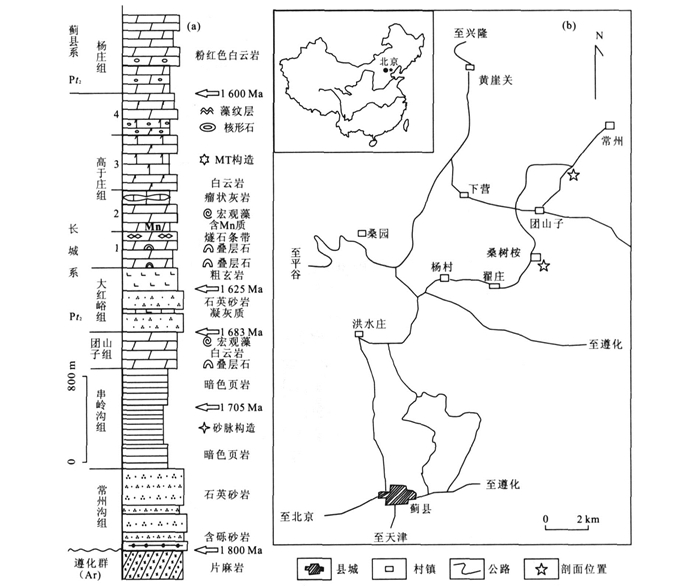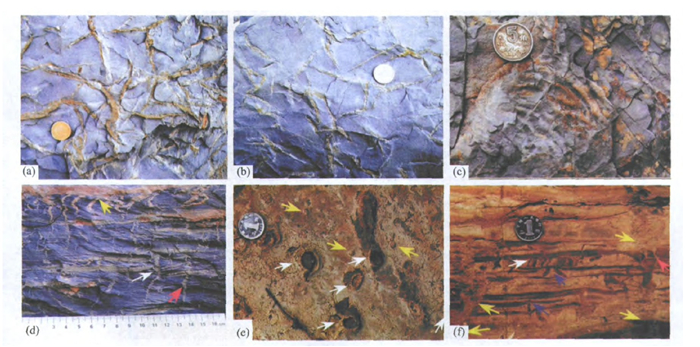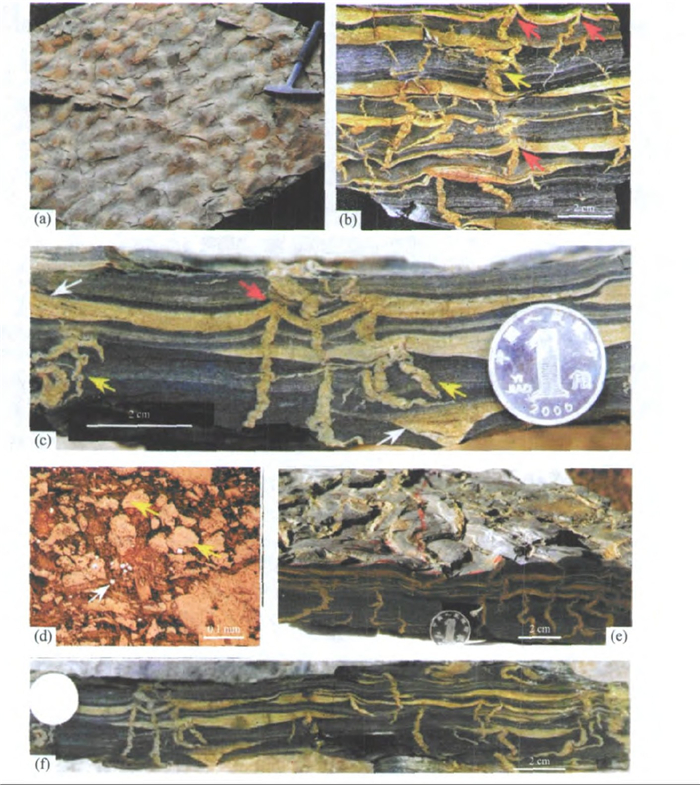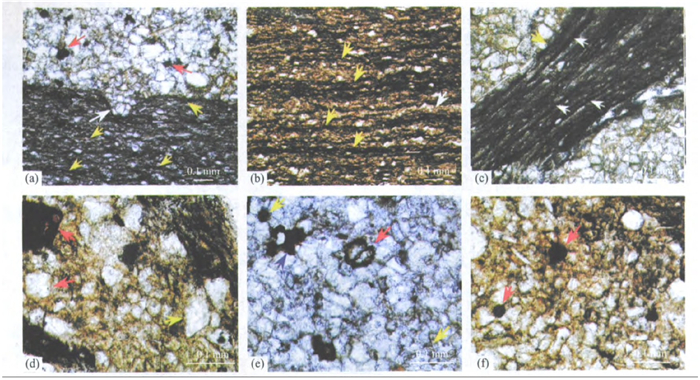Sand Veins and Microbially Induced Sedimentary Structures from the Black Shale of the Mesoproterozoic Chuanlinggou Formation (ca. 1.7 Ga) in North China: Implications for Methane Degassing from Microbial Mats
-
摘要: 华北地台中元古界串岭沟组暗色页岩中发育一种特殊的砂质脉状构造; 层面上表现为不规则密集分布的细砂脊, 垂向上由不连续薄砂层和近于直立的“肠状”砂脉体相交互组成.浅色砂脉由较纯的石英粉砂-细砂组成, 含微量自生白云石、菱铁矿及微晶碳酸盐岩斑块, 与黑色泥质围岩边界截然.研究表明, 砂脉构造可能是在早期成岩阶段前由来自薄砂层的细-粉砂灌入甲烷缓慢逃逸通道而成, 并由于压实缩短而褶皱成“肠状”.薄砂层与黑色页岩形成的能量条件完全不同, 可能系由风暴将海岸带或砂坝细砂带入低能环境而形成; 甲烷源自沉积中埋藏的微生物席腐烂分解.围岩层面有微生物席成因微皱痕和气体逃逸形成的气泡构造, 围岩中发现有细菌化石和草霉状黄铁矿.串岭沟组中密集发育的砂脉构造是目前地层中识别的最古老的甲烷排放证据, 并有可能作为指示地质时期陆源碎屑沉积环境甲烷逃逸的沉积标识.大量高效温室气体进入大气圈可能是导致元古宙地球表层高温室气候和无冰川发育的重要原因.Abstract: The Mesoproterozoic Chuanlinggou Formation (ca. 1.7Ga) consists of up to 900m thick, dark-gray to black shale and fine-grained sandstone that are widespread in the North China platform. Abundant centimeter-scale sand veins are present within the black shale layers of this unit, particularly in the central part. Sand veins display ptygmatic shapes, perpendicular or with a high angle to sedimentary bedding. They penetrate the black shale layers but are vertically discontinuous and often terminated by thin, lenticular sandstone beds, forming small-scale 'tepee-like' structures. On bedding planes, sand veins are expressed as small sand ridges with 1-3mm positive relief. Lack of polygonal shapes and their occurrence in thinly laminated, deep-water shale prevent an origin from sand-filled desiccation cracks. Instead, their close association with microbially induced sedimentary structures (MISS), such as micro-wrinkles and gas blisters, and putative bacteria fossils (possibly coccoidal cyanobacteria) and framboidal pyrites, suggests that they were formed by degassing of methane from microbial mat decay. Methane gas disrupted overlying sedimentary layers, creating fractures open to seawater. Fine-grained quartz sands, which were transported into the depositional environment by storm events, filled the open fractures. Sand-filled fractures were shortened and deformed during burial compaction, forming ptygmatic shapes. The presence of dispersed dolomite and siderite in these sand veins suggests authigenic carbonate precipitation from anaerobic oxidation of methane (AOM). Sand veins are mainly distributed within the Chuanlinggou Formation and are spatially widespread in the North China platform. If their methane origin is confirmed, they may have important implications for the Mesoproterozoic plaeoclimate. With a low seawater sulfate concentration during the Mesoproterozoic, methane release from microbial mat decay and/or microbial methanogenesis during shallow burial may have been proportionally higher than that of the modern marine environments, with resultant increase in the relative importance of methane in maintaining the Mesoproterozoic greenhouse climate.
-
Key words:
- sand veins /
- methane degassing /
- microbial mats /
- Chuanlinggou Formation /
- Mesoproterozoic /
- North China platform
-
图 2 砂脉构造在剖面上的形态特征
a.层面上砂脊交织的复杂形态(硬币直径2.1 cm).b.层面上简单的砂脊形态.c.与砂脉共生围岩层面的皱痕构造(wrinkles, 一种微生物席成因构造).d.砂脉多发育在薄砂层之下, 砂脉向上不能穿越较厚砂层(黄色箭头), 但可穿越薄砂层(白色箭头), 或形成尖顶构造(红色箭头).e.发育在层面上的气泡构造(gas blister), 硬币直径2.1 cm; 破顶的大气泡(白色箭头) 和未破顶的小气泡(黄色箭头); 由气体缓慢逃逸上拱表层微生物席而形成.f.砂脊上顶薄砂层形成的尖顶隆起(蓝色箭头) 以及气体逃逸形成的“烟雾状”扰动构造(黄色箭头); 在上穿薄砂层的砂脉两侧, 存在可见的缝隙(红色箭头).硬币直径2.1 cm
Fig. 2. Photographs showing morphology of the sand vein structures on outcrops
图 4 砂脉构造的显微特征
a.砂脉与围岩接触界线截然, 泥岩富有机质纹层(黄色箭头), 砂脉中含黄铁矿(红色箭头); b.围岩中发育微生物席(膜, 黄色箭头) 以及选择性粘结形成的粉砂层(白色箭头); c.微生物膜(白色箭头) 构成的复合微生物席层(暗色) 与砂脉形成鲜明对比; d.砂脉由石英粉砂英组成, 分选较好, 含自生白云石(黄色箭头) 和菱铁矿(红色箭头); e.砂脉中有疑似微生物化石(红色箭头) 与草莓状黄铁矿(黄色箭头); f.砂脉中草莓状黄铁矿(红色箭头)
Fig. 4. Photographs showing microscopic features of the sand veins
-
Anbar, A. D., Knoll, A. H., 2002. Proterozoic ocean chemistry and evolution: A bioinorganic bridge. Science, 297 (5584): 1137-1142. doi: 10.1126/science.1069651 Bishop, J. W., Sumner, D. Y., Huerta, N. J., 2006. Molar tooth structures of the Neoarchean Monteville Formation, Transvaal Supergroup, South AfricaⅡ: A wave-induced fluid flow model. Sedimentology, 53 (5): 1069-1082. doi: 10.1111/j.1365-3091.2006.00802.x Brocks, J. J., Love, G. D., Summons, R. E., et al., 2005. Biomarker evidence for green and purple sulphur bacteria in a stratified Palaeoproterozoic sea. Nature, 437 (7060): 866-870. doi: 10.1038/nature04068 Canfield, D. E., 2005. The early history of at mospheric oxygen: Homage to Robert A. Garrels. Annu. Rev. Earth Pl. Sc., 33: 1-36. doi: 10.1146/annurev.earth.33.092203.122711 Catling, D. C., Claire, M. W., 2005. How earth′s at mosphere evolved to an oxic state: A status report. Earth Planet Sc. Lett., 237 (1-2): 1-20. doi: 10.1016/j.epsl.2005.06.013 Catling, D. C., Claire, M. W., Zahnle, K. J., 2007. Anaerobic methanotrophy and the rise of at mospheric oxygen. Philosl. Trans. Roy. Soc. A., 365 (1856): 1867-1888. doi: 10.1098/rsta.2007.2047 Chen, J. B., Zhang, H. M., Zhu, S. X., et al., 1980. Study of the sinian suberathem of Jixian. The sinian suberathem of China. Science and Technology Press, Tianjin, 55-109 (in Chinese). Chu, X., Zhang, T., Zhang, Q., et al., 2004. Carbon isotopic variations of Proterozoic carbonates in Jixian, Tianjin, China. Science in China (Ser. D), 47 (2): 160-170. Claire, M. W., Catling, D. C., Zahnle, K. J., 2006. Biogeochemical modelling of the rise in at mospheric oxygen. Geobiology, 4 (4): 239-269. doi: 10.1111/j.1472-4669.2006.00084.x Corsetti, F. A., Grotzinger, J. P., 2005. Origin and significance of tube structures in neoproterozoic post-glacial cap Carbonates: Example from noonday dolomite, death valley, United States. Palaios, 20 (4): 348. doi: 10.2110/palo.2003.p03-96 Eriksson, P. G., Schieber, J., Bouougri, E., et al., 2007. Classification of structures left by microbial mats in their host sedi ments. In: Schiber, J., Bose, P. K., Eriksson, P. G., et al., eds., Atlas of microbial mat features preserved with the clastic rock record. Elsevier, Amsterdam, 39-52. Fairchild, I. J., Einsele, G., Song, T. R., 1997. Possible seismic origin of molar-tooth structures in Neoproterozoic carbonate ramp deposits, North China. Sedimentology, 44 (4): 611-636. doi: 10.1046/j.1365-3091.1997.d01-40.x Fraiser, M. A., Corsetti, F. R., 2003. Neoproterozoic carbonate shrubs: Interplay of microbial activity and unusual environmental conditions in Post-Snowball earth oceans. Palaios, 18 (4-5): 378-387. doi: 10.1669/0883-1351(2003)018<0378:NCSIOM>2.0.CO;2 Frank, T. D., Lyons, T. W., 1998. "Molar-tooth" structures: A geochemical perspective on a Proterozoic enigma. Geology, 26 (8): 683-686. doi: 10.1130/0091-7613(1998)026<0683:MTSAGP>2.3.CO;2 Furniss, G., Rittel, J. F., Winston, D., 1998. Gas bubble and expansion crack origin of "molar-tooth" calcite structures in the Middle Proterozoic belt supergroup, western Montana. J. Sediment. Res., 68 (1): 104-114. doi: 10.2110/jsr.68.104 Gao, L., Zhang, C., Shi, X., et al., 2007. A new SHRIMP age of the Xiamaling Formation in the North China plate and its geological significance. Acta Geologica Sinica, 81 (6): 1103-1108. doi: 10.1111/j.1755-6724.2007.tb01032.x Gerdes, G., Klenke, T., Noffke, N., 2000. Microbial signatures in peritidal siliciclastic sediments: A catalogue. Sedimentology, 47 (2): 279-308. Gerdes, S., 2007. Structures left by modern microbial mats in their host sediments. In: Schiber, J., Bose, P. K., Eriksson, P. G., et al., eds., Atlas of microbial mat features preserved with the clastic rock record. Elsevier, Amsterdam, 5-38. Gradstein, F. M., Ogg, J. G., Smith, A. G., et al., 2004. A geological time scale 2004. Episodes, 27 (2): 1-11. Hoff man, P. F., Kauf man, A. J., Halverson, G. P., et al., 1998. A neoproterozoic snowball earth. Science, 281 (5381): 1342-1346. doi: 10.1126/science.281.5381.1342 Hoff man, P. F., Schrag, D. P., 2002. The snowball earth hypothesis: Testing the limits of global change. Terra Nova, 14 (3): 129-155. doi: 10.1046/j.1365-3121.2002.00408.x Holland, H. D., 2006. The oxygenation of the atmosphere and oceans. Phil. Trans. Roy. Soc. B-Biol. Sci., 361 (1470): 903-915. doi: 10.1098/rstb.2006.1838 James, N. P., Narbonne, G. M., Sherman, A. G., 1998. Molartooth carbonates: Shallow subtidal facies of the mid-to Late Neoproterozoic. J. Sediment. Res., 68 (5): 716-722. doi: 10.2110/jsr.68.716 Jiang, G., Kennedy, M. J., Christie-blick, N., 2003. Stable isotopic evidence for methane seepsin Neoproterozoic postglacial cap carbonates. Nature, 426 (6968): 822-826. doi: 10.1038/nature02201 Jiang, G., Shi, X., Zhang, S., 2006. Methane seeps, methane hydrate destabilization, and the Late Neoproterozoic postglacial cap carbonates. Chinese Sci. Bull., 51 (10): 1152-1173. doi: 10.1007/s11434-006-1152-y Kah, L. C., Riding, R., 2007. Mesoproterozoic carbon dioxide levels inferred from calcified cyanobacteria. Geology, 35 (9): 799-802. doi: 10.1130/G23680A.1 Kasting, J. F., 2004. When methane made climate. Sci. Am., 291 (1): 78-85. doi: 10.1038/scientificamerican0704-78 Kasting, J. F., Catling, D., 2003. Evolution of a habitable planet. Annu. Rev. Astron. Astr., 41: 429-463. doi: 10.1146/annurev.astro.41.071601.170049 Kasting, J. F., Howard, M. T., Wall mann, K., et al., 2006. Paleoclimates, ocean depth, and the oxygen isotopic composition of seawater. Earth Planet. Sc. Lett., 252 (1-2): 82-93. doi: 10.1016/j.epsl.2006.09.029 Kauf man, A. J., Xiao, S., 2003. High CO2 levels in the Proterozoic atmosphere estimated from analyses of individual microfossils. Nature, 425: 279-282. doi: 10.1038/nature01902 Kirschvink, J. L., Gaidos, E. J., Bertani, L. E., et al., 2000. Paleoproterozoic snowball earth: Extreme climatic and geochemical global change and its biological consequences. P. Natl. Acad. Sci. U. S. A., 97 (4): 1400-1405. doi: 10.1073/pnas.97.4.1400 Knauth, L. P., 2005. Temperature and salinity history of the Precambrian ocean: Implications for the course of microbial evolution. Palaeogeography, Palaeoclimatology, Palaeoecology, 219 (1-2): 53-69. doi: 10.1016/j.palaeo.2004.10.014 Knoll, A. H., 2003. The geological consequences of evolution. Geobiology, 1 (1): 3-14. doi: 10.1046/j.1472-4669.2003.00002.x Kopp, R. E., Kirschvink, J. L., Hilburn, I. A., et al., 2005. The Paleoproterozoic snowball earth: A climate disaster triggered by the evolution of oxygenic photosynthesis. P. Natl. Acad. Sci. U. S. A., 102 (32): 11131-11136. doi: 10.1073/pnas.0504878102 Li, C., Yan, Y. Z., 2001. Characteristics of the biomarkers in the Proterozoic, Jixian. Earth Science Frontiers, 8 (4): 453-462 (in Chinese with English abstract). Li, H. K., Li, H. M., Lu, S. N., 1995. The SHRIMP age for the Tuanshanzi Formation of the Changcheng system and its significance. Chin. Jour. Geochem., 24 (1): 43-51 (in Chinese with English abstract). Liu, H. F., Liu, C. Y., 1992. The oldest possible metazoan trace fossils discovered from the Chuanlinggou Formation of the Changcheng System, Jixian. Journal ofNorthwest University (Natural Science Edition), 22 (3): 268-270 (in Chinese with English abstract). Liu, W. F., Meng, X. H., Ge, M., et al., 2004. Origin of the Neoproterozoic molar-tooth carbonates in the Xuzhou-Huainan area. Geological Review, 50 (5): 454-463 (in Chinese with English abstract). Liu, Y. Q., Gao, L. Z., Liu, Y. X., 2005. Neoproterozoic molar-tooth structure and constraint of depositional facies and environment in the North China platformin Jiangsu, Anhui and Liaoning, eastern China. Acta Geologica Sinica, 79 (4): 533-539. doi: 10.1111/j.1755-6724.2005.tb00919.x Lu, S. N., 1998. Discussion on some problems in the geochronologic subdivision of the Proterozoic in China. Progress in Precambrian Research, 21 (4): 1-9 (in Chinese with English abstract). Lu, S., Yang, C., Li, H., et al., 2002. A group of rifting events in the terminal Paleoproterozoic in the North China craton. Gondawana Research, 5 (1): 123-131. doi: 10.1016/S1342-937X(05)70896-0 Marshall, D., Anglin, C. D., 2004. CO2-clathrate destabilization: A new model of formation for molar tooth structures. Precambrian Res., 129 (3-4): 325-341. doi: 10.1016/j.precamres.2003.10.007 Mei, M. X., 2006. Origin of molar-tooth structure based on sequence-stratigraphic position and macroscopic features: Example from Mesoproterozoic Gaoyuzhuang Formation at Jixian Section, Tianjin, North China. Journal of China University of Geosciences, 17 (3): 201-208. Mei, M. X., 2007. Implications of the Precambrian non-stromatolitic carbonate succession making up the third member of mesoproterozoic Gaoyuzhuang Formation in Yanshan area of North China. Earth Science—Journal of China University of Geosciences, 18 (3): 191-209. doi: 10.1016/S1002-0705(08)60001-1 Meng, X. H., Ge, M., Kuang, H. W., 2006. Origin of Microsparite carbonates and the significance in the evolution of the earth in Proterozoic. Acta Petrologica Sinica, 22 (8): 2133-2143 (in Chinese with English abstract). Meng, X. H., Ge, M., 2002. The sedimentary features of Proterozoic microspar (Molar-tooth) carbonates in China and their significance. Episodes, 25 (3): 185-196. doi: 10.18814/epiiugs/2002/v25i3/003 Meng, X. H., Ge, M., Liu, Y. X., et al., 2004. Molar-tooth carbonate sequences and Sr isotopes in the Neoproterozoic for stratigraphic correlation: Research in the Jilin, Liaoning, Xuzhou, Huaiyang areas of the Sino-Korean plate and its correlation with the Yangtze plate. ActaGeologica Sinica, 78 (3): 775-783. Niu, S. W., 2002. Study of the macroalgal fossils from the Middle and Late Proterozoic of the Yan-Liao area, North China. Progress in Precambrian Research, 25 (1): 28-35 (in Chinese with English abstract). Noffke, N., Gerdes, G., Klenke, T., et al., 2001. Microbially induced sedi mentary structures: A new category within the classification of pri mary sedi mentary structures. Palaios, 71: 649-656. Noffke, N., Gerdes, G., Klenke, T., 2003. Benthic cyanobacteria and their influence on the sedimentary dynamics of peritidal depositional systems (siliciclastic, evaporiticsalty, and evaporitic carbonatic). Earth Science Reviews, 62 (1-2): 163-176. doi: 10.1016/S0012-8252(02)00158-7 Pavlov, A. A., Hurtgen, M. T., Kasting, J. F., et al., 2003. Methane-rich proterozoic at mosphere? Geology, 31 (1): 87-90. doi: 10.1130/0091-7613(2003)031<0087:MRPA>2.0.CO;2 Pavlov, A. A., Kasting, J. F., Brown, L. L., et al., 2000. Greenhouse warming by CH4 in the at mosphere of early earth. Journal of Geophysical Research, 105 (E5): 11981-11990. doi: 10.1029/1999JE001134 Peckmann, J., Goedert, J. L., 2005. Geobiology of ancient and modern methane-seeps. Palaeogeography, Palaeocli matology, Palaeoecology, 227 (1-3): 1-5. doi: 10.1016/j.palaeo.2005.02.016 Peckmann, J., Thiel, V., 2004. Carbon cycling at ancient methane-seeps. Chem. Geol., 205 (3-4): 443-467. doi: 10.1016/j.chemgeo.2003.12.025 Peng, Y. B., Wang, D., Yuan, X. L., 2007. Ultrastructure of spheroidal acritarchs from the Chuanlinggou Formation of the Changcheng System. Acta Micropaleontologica Sinica, 24 (2): 194-204. (in Chinese with English ab-stract). Pflüger, F., Gresse, P. G., 1996. Microbial sand chips—A non-actualistic sedimentary structure. Sediment. Geol. 102 (3-4): 263-271. doi: 10.1016/0037-0738(95)00072-0 Pierre, C., Fouquet, Y., 2007. Authigenic carbonates from methane seeps of the Congo deep-sea fan. Geo-Mar. Lett., 27 (2): 249-257. Pollock, M. D., Kah, L. C., Bartley, J. K., 2006. Morphology of molar-tooth structures in Precambrian carbonates: Influence of substrate rheology and implications for gene-sis. J. Sediment. Res., 76 (2): 310-323. doi: 10.2110/jsr.2006.021 Porada, H., Hafid, B. E., 2007. Wrinkle structures—A critical review. Earth Science Reviews, 81 (3-4): 199-215. doi: 10.1016/j.earscirev.2006.12.001 Pratt, B. R., 1998a. Molar-tooth structure in Proterozoic carbonate rocks: Origin from synsedimentary earthquakes, and implications for the nature and evolution of basins and marine sediment. Geol. Soc. Am. Bull., 110 (8): 1028-1045. doi: 10.1130/0016-7606(1998)110<1028:MTSIPC>2.3.CO;2 Pratt, B. R., 1998b. Syneresis cracks: Subaqueous shrinkage in argillaceous sediments caused by earthquake induced dewatering. Sediment. Geol., 117 (1-2): 1-10. doi: 10.1016/S0037-0738(98)00023-2 Qiao, X. F., Gao, L. Z., 2007. Mesoproterozoic seismic events and paleogeography in the Yanliao Aulagogen. Journal of Paleogeography, 9 (4): 337-352 (in Chinese with English abstract). Qiao, X. F., Song, T. R., Gao, L. Z., 1994. Seismic sequences in carbonate rocks by vibrational liquefaction. Acta Geologica Sinica, 7 (2): 243-265. Qiao, X. F., Gao, L. Z., 1999. Mesoproterozoic, Neoproterozoic and early Paleozoic earthquake events in North China and its relationship with supercontinental Rodinia. Chinese Sci. Bull., 44 (16): 1753-1757. doi: 10.1360/csb1999-44-16-1753 Reitner, J., Peckmann, J., Rei mer, A., et al., 2005. Methane-derived carbonate build-ups and associated microbial communities at cold seeps on the lower Cri mean shelf (Black Sea). Facies, 51 (1): 66-79. Riding, R., 2006. Cyanobacterial calcification, carbon dioxide concentrating mechanisms, and Proterozoic-cambrian changes in at mospheric composition. Geobiology, 4 (4): 299-316. doi: 10.1111/j.1472-4669.2006.00087.x Robert, F., Chaussidon, M., 2006. A palaeotemperature curve for the Precambrian oceans based on silicon isotopes in cherts. Nature, 443 (7114): 969-973. doi: 10.1038/nature05239 Rogers, J. J., Santosh, M., 2002. Configuration of Columbia, a Mesoproterozoic supercontinent. Gondwana Res., 5 (1): 5-22. doi: 10.1016/S1342-937X(05)70883-2 Santosh, M., Sajeev, K., Li, J. H., 2006. Extreme crustal metamorphism during Columbia supercontinent assembly: Evidence from North China Craton. GondwanaRes., 10 (3-4): 256-266. Sarkar, S., Banerjee, S., Samanta, P., et al., 2006. Microbial mat-induced sedimentary structures in siliciclastic sediments: Examples from the 1.6 Ga chorhat sandstone, vindhyan supergroup, MP, India. Journal of Earth System Science, 115 (1): 49-58. doi: 10.1007/BF02703025 Schieber, J., 2004. Microbial mats in the silisiclastic rock record: A summary of the diagnostic features. In: Eriksson, P. G., Altermann, W., Nelson, D. R., et al., eds., The precambrian earth: Tempos and events. Elsevier, Amsterdam, 12: 663-673. Schieber, J., 1999. Microbial mats in terrigenous clastics, the challenge of identification in the rock record. Palaios, 14 (1): 3-12. doi: 10.2307/3515357 Seilacher, A., 1999. Biomat-related lifestyles in the Precambrian. Palaios, 14 (1): 86-93. doi: 10.2307/3515363 Sheldon, N. D., 2006. Precambrian paleosols and at mospheric CO2 levels. Precambrian Res., 147 (1-2): 148-155. doi: 10.1016/j.precamres.2006.02.004 Shi, X. Y., Chen, C. Q., 2006. Microbially in duced sedimentary structures (MISS) from the Changcheng Group (Pt2, ca. 1.6 Ga), North China platform, and their implications for an oxygen-defficienct shallowsea environment. In: Yang, Q., Weldon, E. A., Wang, Y. D., eds., Ancient life and modern approaches. University of Science and Technology of China Press, Hefei, 188-189. Shields, A. S., 2002. Molar-tooth microspar: A chemical explanation for its disappearance—700 Ma. Terra Nova, 14 (2): 108-113. doi: 10.1046/j.1365-3121.2002.00396.x Song, T. R., 2007. The sedimentary facies indicators and depositional environmental model for the Mesoproterozoic Changcheng systemin the Shisanling area, Beijing. Journal of Paleogeography, 9 (5): 461-472 (in Chi-nese with English abstract). Song, T. R., He, Z. J., Ding, X. Z., 2000. A study of geological event records in the Proterozoic Chuanlinggou Formation of the Ming Tombs district, Beijing. Geological Review, 46 (4): 400-406 (in Chinese with English abstract). Sun, S. F., Zhu, S. X., 2000. Palaeoproterozoic eukaryotic fossils from North China. Acta Geol. Sinica, 74 (2): 116-122 (in Chinese with English abstract). Sun, S. F., Zhu, S. X., Huang, X. G., et al., 2004. Discovery of Parachuaria fossils from the Chuanlinggou Formationin the Changcheng System, Yanshan region and its significance. Acta Geologica Sinica, 78 (6): 721-725 (in Chinese with English abstract). Wang, H., Wang, H. J., Chen, T., et al., 2005. Study of two-dimensional nanometer illite in Jixian County, Tianjin City. Geological Review, 51 (3): 319-324 (in Chinese with English abstract). Wang, J., Chen, J. F., Dou, Q. L., 2004. Evaluation of the hydrocarbon-generating potential the Middle-Upper Proterozoic in North China. Petroleum Geology and Experiment, 26 (2): 206-211 (in Chinese with English abstract). Wang, J., Jiang, G., Xiao, S., et al., 2008. Carbonisotope evidence for widespread methane seeps in the ca. 635 Ma Doushantuo cap carbonate in South China. Geology, 36 (5): 347-350. doi: 10.1130/G24513A.1 Wu, T. S., 2002. Late Precambrian (Meso- to Neoproterozoic) lithostratigraphic units in North China and their multiple division and correlation. Geology in China, 29 (2): 147-154 (in Chinese with English abstract). Xu, D. B., Wang, D. Z., Bai, Z. D., et al., 2002. Sedimentary environment and facies model of the Mesoproterozoic Chuanlinggou Formation in the Xinglong area, Hebei. Geology in China, 29 (2): 167-171 (in Chinese with English abstract). Yan, Y. Z., Liu, Z. L., 1998. Discussion on the relationships between bio-community and paleoenvironment in the Mesoproterozoic Changcheng System, Yanshan area, North China. Acta Micropaleontologia Sinica, 15 (3): 249-266 (in Chinese with English abstract). Zhang, Q. D., Song, T. R., He, Z. J., et al., 2002. Pb-Pb Age determination of Meso- to Neoproterozoic carbonates in the Ming Tombs district, Beijing. Geologocal Review, 48 (4): 416-423 (in Chinese with English abstract). Zhao, G. C., Sun, M., Wilde, S. A., et al., 2003. Assembly, accretion and breakup of the Paleo-Mesoproterozoic Columbia supercontinent: Records in the North China craton. Gondwana Res., 6 (3): 417-434. doi: 10.1016/S1342-937X(05)70996-5 Zhu, S. X., Xing, Y. S., Zhang, P. Y., et al., 1994. Biostratigraphic succession in the Meso- and Neoproroterozoic of North China platform. Geological Publishing House, Beijing, 119-125 (in Chinese). 陈晋镳, 张惠民, 朱士兴, 等, 1980. 蓟县震旦亚界研究. 中国震旦亚界. 天津: 科学技术出版社, 1-219. https://www.cnki.com.cn/Article/CJFDTOTAL-DZXE197803003.htm 李超, 阎玉忠, 2001. 蓟县剖面元古宙沉积物(1.8-0.85 Ga) 中的生物标志化合物特征. 地学前缘, 8 (4): 453-462. doi: 10.3321/j.issn:1005-2321.2001.04.029 李怀坤, 李惠民, 陆松年, 1995. 长城系团山子组火山岩颗粒锆石U-Pb年龄及其地质意义. 地球化学, 24 (1): 43-48. doi: 10.3321/j.issn:0379-1726.1995.01.004 刘洪福, 刘池洋, 1992. 蓟县中元古界长城群串岭沟组中发现最古老的后生动物遗迹化石. 西北大学学报(自然科学版), 22 (3): 268-270. https://www.cnki.com.cn/Article/CJFDTOTAL-XBDZ199203005.htm 刘为付, 孟祥化, 葛铭, 等, 2004. 徐州-淮南地区新元古代臼齿碳酸盐岩成因探讨. 地质论评, 50 (5): 454-463. doi: 10.3321/j.issn:0371-5736.2004.05.002 陆松年, 1998. 关于中国元古宙地质年代划分几个问题的讨论. 前寒武纪研究进展, 21 (4): 1-9. doi: 10.3969/j.issn.1672-4135.1998.04.001 孟祥化, 葛铭, 旷红伟, 2006. 微亮晶(臼齿) 碳酸盐成因及其在元古宙地球演化中的意义. 岩石学报, 22 (8): 2133-2143. https://www.cnki.com.cn/Article/CJFDTOTAL-YSXB200608002.htm 牛绍武, 2002. 燕辽地区中、晚元古代宏观藻类化石研究. 前寒武纪研究进展, 25 (1): 28-35. doi: 10.3969/j.issn.1672-4135.2002.01.004 彭永波, 王丹, 袁训来, 2007. 长城系串岭沟组球形疑源类的超微结构. 微体古生物学报, 24 (2): 194-204. doi: 10.3969/j.issn.1000-0674.2007.02.005 乔秀夫, 高林志, 2007. 燕辽裂陷槽中元古代古地震与古地理. 古地理学报, 9 (4): 337-352. doi: 10.3969/j.issn.1671-1505.2007.04.001 宋天锐, 2007. 北京十三陵地区中元古界长城系沉积相标志及沉积环境模式. 古地理学报, 9 (5): 461-472. doi: 10.3969/j.issn.1671-1505.2007.05.004 宋天锐, 和政军, 丁孝忠, 等, 2000. 北京十三陵中元古代串岭沟期地质事件的探索. 地质论评, 46 (4): 400-406. doi: 10.3321/j.issn:0371-5736.2000.04.008 孙淑芬, 朱士兴, 2000. 华北地区古元古代真核生物化石. 地质学报, 74 (2): 116-122. doi: 10.3321/j.issn:0001-5717.2000.02.003 孙淑芬, 朱士兴, 黄学光, 等, 2004. 燕山长城系串岭沟组Parachuaria化石的发现及其意义. 地质学报, 78 (6): 721-725. doi: 10.3321/j.issn:0001-5717.2004.06.001 王欢, 王河锦, 陈涛, 等, 2005. 天津蓟县二维纳米级伊利石研究. 地质论评, 51 (3): 319-324. doi: 10.3321/j.issn:0371-5736.2005.03.012 王杰, 陈践发, 窦启龙, 2004. 华北北部中、上元古界生烃潜力特征研究. 石油实验地质, 26 (2): 206-211. doi: 10.3969/j.issn.1001-6112.2004.02.014 武铁山, 2002. 华北晚前寒武纪(中—新元古代) 岩石地层单位及多重划分对比. 中国地质, 29 (2): 147-154. doi: 10.3969/j.issn.1000-3657.2002.02.008 徐德斌, 王敦则, 白志达, 等, 2002. 河北兴隆地区中元古界串岭沟组沉积环境与相模式. 中国地质, 29 (2): 167-171. doi: 10.3969/j.issn.1000-3657.2002.02.011 阎玉忠, 刘志礼, 1998. 中国北方燕山盆地长城纪生物群落和古环境关系探讨. 微体古生物学报, 15 (3): 249-266. https://www.cnki.com.cn/Article/CJFDTOTAL-WSGT803.002.htm 张巧大, 宋天锐, 和政军, 等, 2002. 北京十三陵地区中—新元古界碳酸盐岩Pb-Pb年龄研究. 地质论评, 48 (4): 416-423. doi: 10.3321/j.issn:0371-5736.2002.04.012 朱士兴, 邢裕盛, 张鹏远, 1994. 华北地台中、上元古界生物地层序列. 北京: 地质出版社, 119-125. -










 下载:
下载:




